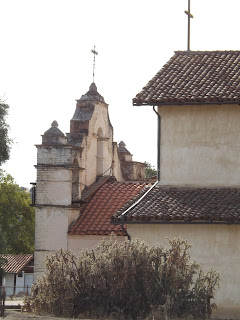The 21 California missions were
the first permanent European settlements to be founded on the West coast,
beginning in 1769.
Located on eighty pristine acres
on what was once the Milpitas unit of the sprawling Hearst Ranch, Mission San
Antonio de Padua sits within the “Valley of the Oaks.” It is called “the mission that forgot time,”
and rightfully touts itself as the “most authentic” mission.
On July 14, 1771, Padres Junipero
Serra, Miguel Pieras and Buenaventura Sitjar hung the bells on the branches of
an oak tree and named this mission San Antonio de Padua. Fr. Pieras and Sitjar
were left with a small group to start the Mission.
The mission was named for St.
Anthony, called "St. Anthony of Padua" because of his long residence
in that city, was a native of Lisbon in Portugal, where he was born in 1195,
receiving the name of Ferdinand at his Baptism. Even during his lifetime, he
was regarded as a legendary hero and striking miracles were related about him:
his sermon to the fish at Rimini, the mule that knelt before the Blessed
Sacrament, the Psalter that was stolen and returned (of which he has become the
patron of those who have lost something), and the story of how his host saw him
holding the Child Jesus in his arms when he looked through his window.
The first Catholic wedding to
take place in California occurred here in 1773 between a Salinan Indian woman
named Margaretta de Cortona and Spanish solider Juan Maria Ruiz. San Antonio de
Padua was the first Alta California mission with a fired-tile or teja roof, and
the very first with over 1,000 neophytes. San Antonio de Padua was known for
the excellence of its music. Displays in the museum show musical notations on
the walls and a large diagram of hand signals used to teach the neophytes.
This mission quickly became
self-sufficient. Over the years it was an active mission San Antonio harvasted
110,000 bushels of wheat, barley, corn, beans and peas. In its peak livestock year of 1828 the mission
had 20,118 animals, including 8,000 cattle and 10,000 sheep. For practicality
the herd was dispersed to several locations. Ranchos San Benito and San Bartolomo
del Pleyto were used for sheep and lambs. There were cattle ranches at Los
Ojitos and Rancho San Miguelito, all within three to ten leagues (10-30 miles)
of the mission.
After secularization, the church
was abandoned. In 1845, Mexican Governor Pío Pico declared all mission
buildings in Alta California for sale, but no one bid for Mission San Antonio. However, in 1851, Fr. Doroteo Ambris, a young
priest who came as seminarian from Mexico, came from Monterey and took up
residence at San Antonio. A few Indian families lived at the Mission with him. The United States government gave the mission
back to the Church in 1863. In 1882, Fr.
Ambris died, and the church was again abandoned and began to fall into greater
disrepair. Later, William Hearst bought the
mission and surrounding land. He
eventually sold it to the US government. Fort Hunter Liggett now encompasses
the mission, and though they own the mission itself, the management is entirely
left to volunteers and supported by donations.
The extensive restoration and
unspoiled setting of San Antonio de Padua makes this one of the most
picturesque missions in California. It has an extensive museum with a number of
exhibits displaying various aspects of daily life at the mission. The site also
boasts the most complete, and largely unrestored, Mission-era water control
system in California.
Mission San Antonio is the best
example of the greater mission environment, due to its undisturbed surroundings
and numerous intact buildings and structures.
For the ultimate mission
experience, stay overnight! There is no food service available.
The mission also has group retreat accommodations and special pricing.
Learn more about the missions and other great places to
visit along the coast in “Along the King’s Road: A Guide to Touring the
California Missions.” Get your copy today!





No comments:
Post a Comment
You are invited to join the conversation!
Please keep the following in mind when posting your comments:
- You do not need to register to comment
- You may comment anonymously
- You may post questions, and I will do my best to respond in a timely fashion.
- You may disagree. But please do so respectfully.
- I reserve the right to delete inappropriate or rude comments.
- You are the sole owner of your comments.
- You grant me license to publish your comments in another venue, royalty free and without limitations, including in a blog, book, video, or presentation.